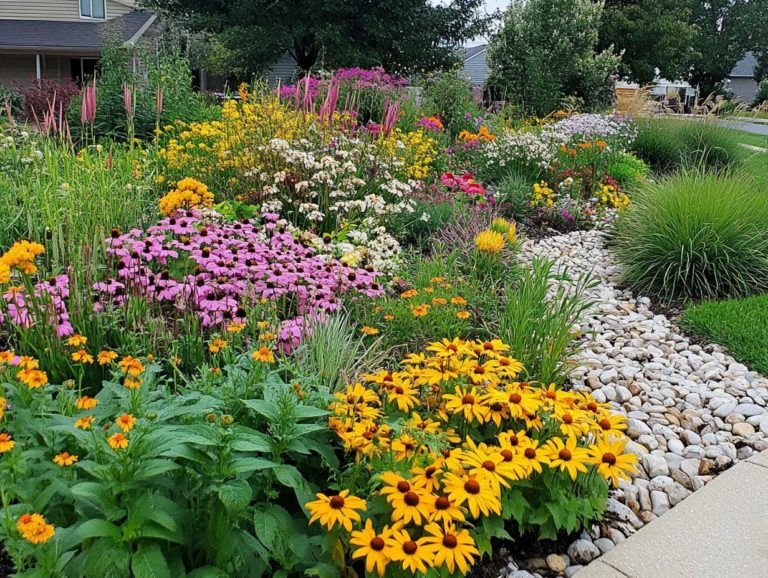How to Optimize Your Plant Care Routine
Caring for houseplants can be a truly rewarding journey, though it certainly presents its own set of challenges.
Understanding the significance of proper plant care techniques is crucial for nurturing healthy growth and vibrant greenery. This article delves into the essential elements of plant care, such as watering schedules, light exposure, and soil nutrition. It also emphasizes common pitfalls to sidestep and provides practical tips to enhance your care routine.
Whether you re a seasoned gardener or a curious plant parent, you ll discover insights tailored to meet the diverse needs of your indoor plants, ensuring your green companions flourish beautifully.
Contents
- Key Takeaways:
- Understanding Plant Care
- Essential Elements of Plant Care
- Common Mistakes in Plant Care
- Optimizing Your Plant Care Routine
- Adapting to Different Plant Needs
- Frequently Asked Questions
- How do I optimize my plant care routine?
- What are some common mistakes to avoid in a plant care routine?
- Why is it important to optimize my plant care routine?
- How can I determine the specific needs of my plants?
- Should I use fertilizer in my plant care routine?
- Can I use natural or organic methods for plant care?
Key Takeaways:

Understanding Plant Care
Dive into plant care techniques for a greener home. Houseplants do more than beautify your space; they help improve your mood and improve air quality. A well-tended collection can help create a serene atmosphere in your living room.
By connecting with the gardening community and mastering plant care, you can grow a beautiful indoor garden that turns your home into a vibrant oasis. From seasonal checklists to plant maintenance planners, you can achieve a stunning array of healthy indoor plants that elevate your home decor.
Importance of Proper Care
Proper care is essential for ensuring that your houseplants thrive and enrich your living space.
Prioritize your plants’ needs, like providing the right light, managing watering schedules, and ensuring adequate nutrition through soil quality and fertilizer. You’ll find that your plants become healthier and more vibrant. These strategies enhance their visual appeal and improve lung health, creating a soothing atmosphere in your home.
A well-maintained indoor garden can be a perfect retreat, fostering relaxation and sparking creativity. By grasping how these elements interact, you can easily cultivate a space that elevates your mood and nurtures your well-being.
Essential Elements of Plant Care
In the realm of plant care, grasping the fundamental elements such as watering schedules, light exposure, and soil quality is crucial for ensuring the vitality of your indoor plants.
Watering and Moisture
Establishing effective watering and moisture management is crucial for your plants’ growth and overall health. This helps your plants get the right amount of water while steering clear of issues like root rot and mold development.
For optimal results, consider developing a tailored watering schedule that aligns with the specific needs of your plants, which can vary by species and seasonal changes. Techniques such as deep watering encourage roots to delve deeper into the soil, enhancing both their stability and nutrient uptake.
Keeping an eye on soil moisture levels with tools like moisture meters tools that measure how wet the soil is can guide you on when to water and when to exercise restraint, helping you avoid the pitfalls of overwatering. If you’re seeking a low-maintenance solution, self-watering planters can be a game changer. These innovative containers maintain a consistent moisture level while allowing excess water to drain away, creating the perfect environment for your plant roots.
Don t forget to select the right potting mix and avoid waterlogged conditions to ensure your plants continue to thrive.
Start creating your perfect indoor garden today!
Light and Sun Exposure

Light exposure is an important part of the growth and development of your indoor plants.
Understanding direct, indirect, and low light can elevate your plant care techniques. For instance, certain species, like succulents and cacti, thrive in direct sunlight when placed on a sunny windowsill.
On the other hand, plants like pothos and snake plants prefer indirect light, flourishing with filtered sunlight.
In low-light conditions, resilient varieties like ZZ plants and peace lilies do well with minimal light. By understanding the specific light requirements of different plants, you can create optimal environments that promote healthy growth.
Soil and Nutrients
The quality of soil and its nutrient composition are crucial for strong plant growth.
Understanding the specific needs of various plant species enhances their vigor. Some plants thrive in sandy soils that drain well, while others flourish in the rich, moisture-retaining qualities of loamy mixes.
The gardening community emphasizes the importance of soil testing to assess pH levels, which measure acidity or alkalinity in soil, and identify nutrient deficiencies. This proactive approach helps in selecting the right fertilizer and contributes to overall soil health.
Engaging with the gardening community or online forums can provide valuable insights into suitable soil types and effective amendments, ensuring that each plant receives the precise care it needs.
Common Mistakes in Plant Care
Recognizing and avoiding common pitfalls in plant care can greatly enhance the vitality and lifespan of your houseplants!
Identifying and Avoiding Mistakes
Identifying mistakes in plant care is essential for nurturing healthy and vibrant plants.
Many enthusiasts overlook key aspects like watering frequency and soil composition, leading to issues like root rot or stunted growth. Familiarize yourself with the specific needs of your plants since different species thrive under varying conditions.
For example, succulents often require minimal water, while ferns enjoy consistent moisture.
Take charge of your plant care by understanding pest management strategies, such as using natural insecticides or introducing beneficial insects. Regularly assess your plants environments to create optimal conditions for thriving greenery!
Optimizing Your Plant Care Routine
Optimizing your plant care routine requires a thoughtful, systematic approach to ensure your houseplants thrive beautifully throughout the seasons!
Tips for Efficient and Effective Care

- Craft a weekly schedule for tasks like watering, pruning, and fertilizing.
- Consider using self-watering pots for easier care.
- Group plants with similar light and water needs to simplify their care.
- Use composting for a natural nutrient boost, reducing reliance on chemical fertilizers.
These thoughtful strategies can transform your plant care routine into a joyful experience! Start optimizing your plant care routine today for a flourishing indoor oasis!
Adapting to Different Plant Needs
Adapting to the distinct needs of various plant species is vital for achieving success in plant ownership and care. Understanding plant identification is key. By knowing the specific requirements of each plant species, you can cultivate a thriving indoor oasis that flourishes under your attentive guidance.
Adjusting Care for Different Types of Plants
Adjusting your care based on plant types is essential. Each species thrives according to its specific needs.
For example, succulents like Echeveria and Aloe Vera thrive in bright, indirect sunlight. They require watering less frequently often just every couple of weeks. In contrast, tropical plants such as the Peace Lily and Pothos flourish in lower light but appreciate consistent moisture in their soil.
Nutrient needs vary significantly among plants. Cacti typically have minimal nutrient requirements, while flowering plants like African Violets benefit from a balanced fertilizer during their growing season. By tailoring your watering schedules, light exposure, and fertilization routines to these preferences, you can create an optimal environment for each plant species to thrive!
Frequently Asked Questions
How do I optimize my plant care routine?
To optimize your plant care routine, follow these steps:
- Determine the specific needs of your plants. Different plants require different levels of sunlight, water, and nutrients.
- Create a schedule for watering and fertilizing based on their needs.
- Use high-quality potting soil and ensure the containers have proper drainage, which is crucial for healthy soil.
- Check your plants regularly for signs of pests or diseases and take action if necessary.
- Rotate your plants to ensure even growth and prevent them from leaning towards the light.
What are some common mistakes to avoid in a plant care routine?

Common mistakes to avoid include:
- Overwatering or underwatering your plants.
- Using low-quality potting soil, which can affect plant nutrients.
- Ignoring signs of pests or diseases.
- Not providing enough sunlight or using incorrect lighting.
Why is it important to optimize my plant care routine?
Optimizing your plant care routine ensures the health and longevity of your plants. By providing proper care, you can prevent diseases, promote growth, and extend their lifespan.
How can I determine the specific needs of my plants?
You can determine your plants’ needs by researching their species or consulting a gardening expert. Pay attention to individual characteristics like leaf color, growth patterns, and overall health.
Should I use fertilizer in my plant care routine?
Yes, fertilizer is crucial for optimizing your plant care routine. It provides essential nutrients that may be lacking in the soil and promotes healthy growth. Just use the correct type and amount of fertilizer for your specific plants.
Can I use natural or organic methods for plant care?
Absolutely! Many natural or organic methods can be as effective as traditional ones. Examples include natural pest repellents, composting, and natural fertilizers. Research and experiment to find what works best for your plants.
Start optimizing your plant care today and watch your indoor garden flourish!






